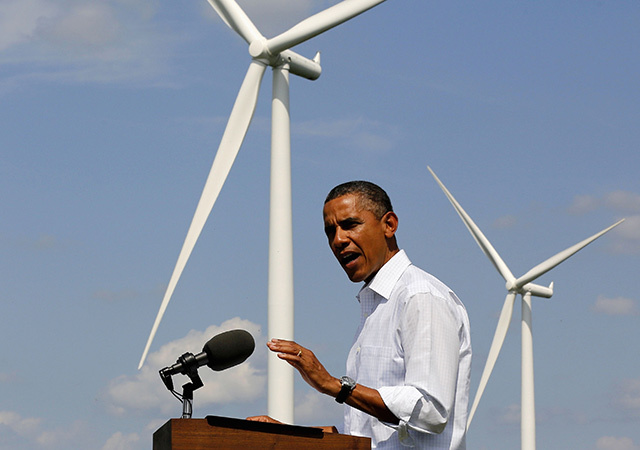
The U.S. Supreme Court may have put President Barack Obama’s most aggressive plan to curb power- plant emissions on hold Tuesday. That’s not going to save coal from a shrinking market, or stop some states and utilities from moving forward with their own measures.
The Environmental Protection Agency had projected that coal’s share of America’s power mix would shrink to 27 percent in 2030 under the historic Clean Power Plan. It was already down to 29 percent in November, based on government data, as cheap natural gas and renewables stole market share. U.S. rules including one regulating pollution across state lines and local renewable energy policies will continue to force coal-fired power plants into retirement.
“This might buoy sentiment for coal, but I don’t think there are any practical market implications,” said Cheryl Wilson, an energy policy analyst for Bloomberg Intelligence. “I don’t think you would see a utility change their decisions based on this ruling.”
Tuesday’s Supreme Courtdecision freezes in its tracks an unprecedented policy that Obama had established as the centerpiece of his energy and environmental legacy. It would require states and utilities to use less coal and employ more wind, solar and natural gas-fired power to achieve carbon emissions cuts of 32 percent by 2030 from 2005 levels.
U.S. Coal miner Peabody Energy Corp. described the ruling as a “victory for American families and businesses who value reliability and diversity of energy sources.” Mike Duncan, president of the American Coalition for Clean Coal Electricity, said the decision shows the “Supreme Court has serious concerns with the power plan.”
Sierra Club, meanwhile, said the hold shouldn’t give the coal industry false hope. “The transition we’re experiencing in the electric sector away from coal and other fossil fuels to clean energy has been going on for years and will continue,” Joanne Spalding, managing attorney for the group, said by phone. “EPA is following the trends that are already occurring in the electric sector — not creating new trends.”
Diversifying Mix
American Electric Power Co., one of the biggest coal- burning U.S. utilities, said the Supreme Court decision won’t change the company’s plans “to continue to diversify the fuel mix of our generation fleet.” AEP has said it sees a $10 billion investment opportunity in renewable energy over the next 18 years even before considering the impact of the carbon regulations.
“This is not the end of the story,” Gregory Wetstone, chief executive officer of the American Council on Renewable Energy, said of the court ruling. “Public and private sector momentum behind the shift to lower carbon power generation will continue.”
While states including Alabama, West Virginia, Missouri and Texas hailed the court’s decision as a win for those who argue the rules are overreaching and illegal, West Virginia Attorney General Patrick Morriseyadded that “the impact of the regulation already has been felt in the Mountain State.”
Missouri Attorney General Chris Koster said the state would be better off developing low-emission and clean sources of energy “on a more reasonable timeline.”
Continuing Work
“I think some states, more likely blue states, will be trying to come up with a plan anyway to reduce emissions,” said Paul Patterson, a New York-based analyst for Glenrock Associates LLC. “So this may not halt all efforts to reduce carbon emissions.”
The Environmental Protection Agency has indicated it will keep working with states that decide to proceed with their plans, the White House said in a statement Tuesday. “At the same time,” it said, “the administration will continue to take aggressive steps to make forward progress to reduce carbon emissions.”
Recommended for you
